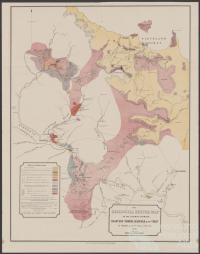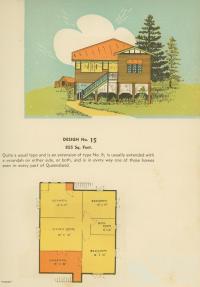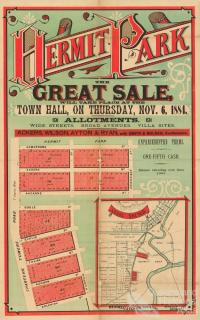- Home
- Quintessential Queensland
- Distinctiveness
- Perceptions
- Perceptions: how people understand the landscape
- From runs to closer settlement
- Geological survey of Queensland
- Mapping a new colony, 1860-80
- Mapping the Torres Strait: from TI to Magani Malu and Zenadh Kes
- Order in Paradise: a colonial gold field
- Queensland atlas, 1865
- Queensland mapping since 1900
- Queensland: the slogan state
- Rainforests of North Queensland
- Walkabout
- Queenslanders
- Queenslanders: people in the landscape
- Aboriginal heroes: episodes in the colonial landscape
- Australian South Sea Islanders
- Cane fields and solidarity in the multiethnic north
- Chinatowns
- Colonial immigration to Queensland
- Greek Cafés in the landscape of Queensland
- Hispanics and human rights in Queensland’s public spaces
- Italians in north Queensland
- Lebanese in rural Queensland
- Queensland clothing
- Queensland for ‘the best kind of population, primary producers’
- Too remote, too primitive and too expensive: Scandinavian settlers in colonial Queensland
- Distance
- Movement
- Movement: how people move through the landscape
- Air travel in Queensland
- Bicycling through Brisbane, 1896
- Cobb & Co
- Journey to Hayman Island, 1938
- Law and story-strings
- Mobile kids: children’s explorations of Cherbourg
- Movable heritage of North Queensland
- Passages to India: military linkages with Queensland
- The Queen in Queensland, 1954
- Transient Chinese in colonial Queensland
- Travelling times by rail
- Pathways
- Pathways: how things move through the landscape and where they are made
- Aboriginal dreaming paths and trading ways
- Chinese traders in the nineteenth century
- Introducing the cane toad
- Pituri bag
- Press and the media
- Radio in Queensland
- Red Cross Society and World War I in Queensland
- The telephone in Queensland
- Where did the trams go?
- ‘A little bit of love for me and a murder for my old man’: the Queensland Bush Book Club
- Movement
- Division
- Separation
- Separation: divisions in the landscape
- Asylums in the landscape
- Brisbane River
- Changing landscape of radicalism
- Civil government boundaries
- Convict Brisbane
- Dividing Queensland - Pauline Hanson’s One Nation Party
- High water mark: the shifting electoral landscape 2001-12
- Hospitals in the landscape
- Indigenous health
- Palm Island
- Secession movements
- Separate spheres: gender and dress codes
- Separating land, separating culture
- Stone walls do a prison make: law on the landscape
- The 1967 Referendum – the State comes together?
- Utopian communities
- Whiteness in the tropics
- Conflict
- Conflict: how people contest the landscape
- A tale of two elections – One Nation and political protest
- Battle of Brisbane – Australian masculinity under threat
- Dangerous spaces - youth politics in Brisbane, 1960s-70s
- Fortress Queensland 1942-45
- Grassy hills: colonial defence and coastal forts
- Great Shearers’ Strike of 1891
- Iwasaki project
- Johannes Bjelke-Petersen: straddling a barbed wire fence
- Mount Etna: Queensland's longest environmental conflict
- Native Police
- Skyrail Cairns (Research notes)
- Staunch but conservative – the trade union movement in Rockhampton
- The Chinese question
- Thomas Wentworth Wills and Cullin-la-ringo Station
- Separation
- Dreaming
- Imagination
- Imagination: how people have imagined Queensland
- Brisbane River and Moreton Bay: Thomas Welsby
- Changing views of the Glasshouse Mountains
- Imagining Queensland in film and television production
- Jacaranda
- Literary mapping of Brisbane in the 1990s
- Looking at Mount Coot-tha
- Mapping the Macqueen farm
- Mapping the mythic: Hugh Sawrey's ‘outback’
- People’s Republic of Woodford
- Poinsettia city: Brisbane’s flower
- The Pineapple Girl
- The writers of Tamborine Mountain
- Vance and Nettie Palmer
- Memory
- Memory: how people remember the landscape
- Anna Wickham: the memory of a moment
- Berajondo and Mill Point: remembering place and landscape
- Cemeteries in the landscape
- Landscapes of memory: Tjapukai Dance Theatre and Laura Festival
- Monuments and memory: T.J. Byrnes and T.J. Ryan
- Out where the dead towns lie
- Queensland in miniature: the Brisbane Exhibition
- Roadside ++++ memorials
- Shipwrecks as graves
- The Dame in the tropics: Nellie Melba
- Tinnenburra
- Vanished heritage
- War memorials
- Curiosity
- Curiosity: knowledge through the landscape
- A playground for science: Great Barrier Reef
- Duboisia hopwoodii: a colonial curiosity
- Great Artesian Basin: water from deeper down
- In search of Landsborough
- James Cook’s hundred days in Queensland
- Mutual curiosity – Aboriginal people and explorers
- Queensland Acclimatisation Society
- Queensland’s own sea monster: a curious tale of loss and regret
- St Lucia: degrees of landscape
- Townsville’s Mount St John Zoo
- Imagination
- Development
- Exploitation
- Transformation
- Transformation: how the landscape has changed and been modified
- Cultivation
- Empire and agribusiness: the Australian Mercantile Land and Finance Company
- Gold
- Kill, cure, or strangle: Atherton Tablelands
- National parks in Queensland
- Pastoralism 1860s–1915
- Prickly pear
- Repurchasing estates: the transformation of Durundur
- Soil
- Sugar
- Sunshine Coast
- The Brigalow
- Walter Reid Cultural Centre, Rockhampton: back again
- Survival
- Survival: how the landscape impacts on people
- Brisbane floods: 1893 to the summer of sorrow
- City of the Damned: how the media embraced the Brisbane floods
- Depression era
- Did Clem Jones save Brisbane from flood?
- Droughts and floods and rail
- Missions and reserves
- Queensland British Food Corporation
- Rockhampton’s great flood of 1918
- Station homesteads
- Tropical cyclones
- Wreck of the Quetta
- Pleasure
- Pleasure: how people enjoy the landscape
- Bushwalking in Queensland
- Cherbourg that’s my home: celebrating landscape through song
- Creating rural attractions
- Festivals
- Queer pleasure: masculinity, male homosexuality and public space
- Railway refreshment rooms
- Regional cinema
- Schoolies week: a festival of misrule
- The sporting landscape
- Visiting the Great Barrier Reef
By:
Shelley Greer
By:
Karen Phillips Heritage significance is often based on associations between specific places and particular people, groups or events. The idea of ‘movable heritage’ requires a broader frame or a ‘cultural landscape’ that can encompass the movements of people and objects and the spheres of their interactions.
For most people, ‘heritage’ means some kind of inheritance from one generation (or more) to another and is coupled with stable, long-term occupancy. However, in ‘frontier’ zones, heritage is often a more tenuous and less tangible enterprise. This is the case for the settler history of North Queensland, which emerged from industries such as cattle and mining, and where ‘distance’ and ‘movement’ are dominant themes. The isolation of living in remote places meant that the provision of services was often fraught with difficulty. Many aspects of human life, from social engagement to survival, were based on the movement of people and goods, sometimes over long distances.
The city of Townsville, the largest city in tropical Australia, was established in 1864 to provide necessary infrastructure such as a boiling down works and port facilities to support the burgeoning cattle industry. Within a few years, gold fever hit the north and fields at Ravenswood and later Charters Towers (located 90 km and 130 km inland from Townsville) provided further impetus for development. Essential goods were offloaded through the port of Townsville, bound for the gold fields via bullock drays. Hopeful miners also disembarked there, often unaware of the hot dusty walk to the gold fields that lay ahead of them. Connections forged during this period between the large coastal town and the small inland settlements remain to the present day.
Townsville heritage
One of the most intriguing aspects of these connections lies in the many heritage houses found in Townsville that are thought to have been transported from Charters Towers, Ravenswood, or in some cases both. The background to this lies in the adjustments made in design and construction to meet the demand for cheap and easily constructed houses in response to the sudden opening of the gold fields. These changes, that had effects beyond the gold fields, included the use of a light timber frame, simplified and standardised plans and prefabrication. By the early part of the twentieth century, extraction of gold at Ravenswood and Charters Towers was no longer economically viable. People left the fields looking for employment and the empty houses left behind were often transported elsewhere, facilitated by their adapted design and construction.
Although the full extent is unknown, many of Townsville’s heritage houses are anecdotally thought to have been relocated from the gold field towns. According to one source, approximately 1000 houses were transported to Townsville and the nearby Burdekin towns of Ayr and Home Hill in 1917. This suggests that a significant proportion of heritage houses in these centres had their origins on the gold fields. New research is attempting to verify the extent of relocation and whether certain sorts of buildings were favoured for removal. The question as to why this occurred is equally important, although it is likely that (then as now) the transport of existing houses was more economical than building from scratch. Wooden and sometimes iron houses lent themselves to removal, as they could usually be jacked up in some fashion. Brick houses, which were uncommon in Queensland, even in the larger cities, until after World War II, are almost impossible to move because of the weight and cracking of walls. Minor cracking is easy to repair on a wooden house. The technology required to transport the buildings also provides an interesting study. Originally transport was probably on ‘jinkers’ pulled by bullock teams but the railways were also used after the establishment of the line in the late nineteenth century.
This aspect of North Queensland’s heritage raises some important considerations for understanding the past. In particular, it suggests a past of movement and adaptation as much as the more traditional elements of stability and security. The ‘settlers’ were often people on the move and even their buildings (often the most immovable elements of the past) were moved!
Removal history
This movable or transportable aspect of heritage raises some important issues that continue to the present. Recently a house that had been moved from Charters Towers to South Townsville in 1915 was purchased for removal to a new development on Townsville’s outskirts. The house (including its ‘removal’ history) was listed on the Townsville City Council’s local heritage database. The issue for heritage managers is the degree to which the cultural significance of the house lay in its origins in Charters Towers, the 92 years it spent in South Townsville, and/or the fact that it is part of a continuing practice of removals.
The heritage value of this house and others like it is most likely tied up in all the layers of its history. While it is sometimes difficult to think of ‘heritage’ in the present, continuity of practice such as is described here provides a good illustration of the fact that much of what is inherited is intangible practice.
References and Further reading (Note):
Peter Bell, Timber and iron: houses in North Queensland mining settlements 1861-1920, St Lucia, University of Queensland Press, 1984
References and Further reading (Note):
Peter Bell, A history of the Queensland house, Adelaide, Historical Research, 2002
References and Further reading (Note):
Jenny Gregory, 'Reconsidering relocated buildings: ICOMOS, authenticity and mass relocation', International journal of heritage studies, 14:2, March 2008, pp112-30
Copyright © Shelley Greer & Karen Phillips, 2010
Related:
Movement 





